With the end of lockdown in sight, holiday bookings to Greece are surging, as people plan what will be some of the most-anticipated holidays ever. For a really restorative taste of Greek life, though, it’s worth swapping the limelight locations for places where mass tourism hasn’t obscured the essence of Greek culture: hospitality and a soulful way of life.
These 10 stunning island and mainland destinations offer a more nourishing side of Greece. These are places where people take pride in offering hospitality – in line with the ancient custom of filoxenia, love of strangers – and where things are done with meraki, love and soul.
These are the sort of locations that made people fall in love with Greece in the first place, where the Arcadian idea of the good life, pondered by the ancients, is still alive and well.
Andros
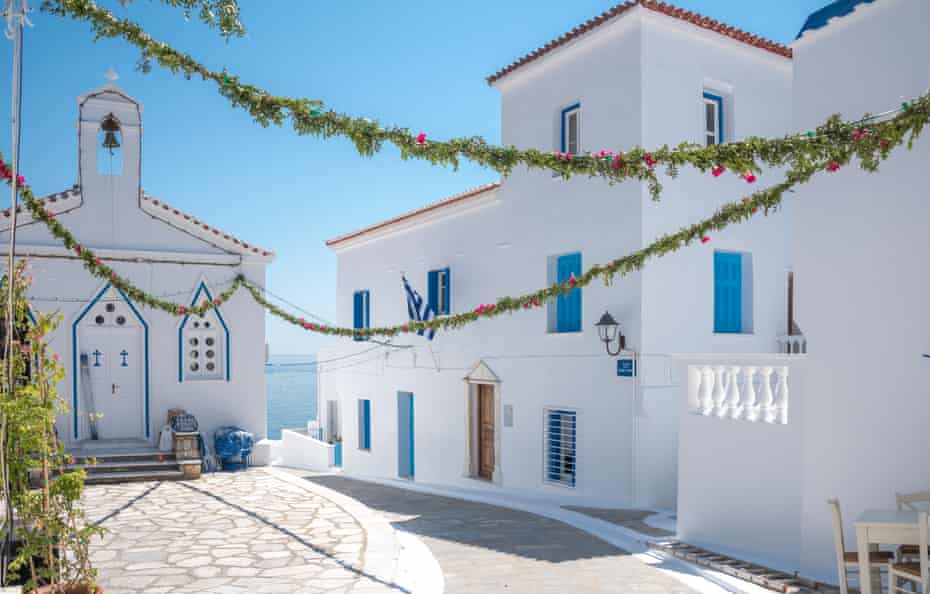
Two hours from the port of Rafina, near Athens, this mountainous island is the northernmost of the Cyclades archipelago and a favourite with holidaying Greeks for its food, beaches and pretty villages. More fertile and greener than the rest of the Cyclades, the island has a well-maintained network of trails,making it a hiker’s paradise.
What to do
Rent a car that can go off-road, as some of the best places are reached down dirt tracks. The main town, Chora, is a cluster of neoclassical mansions that juts out to sea, with a marbled square and impressive museums dedicated to contemporary art, archaeology and folklore. The seaside town of Batsi is where most tourists stay, but it’s still relatively quiet, with a selection of tavernas and coffee shops.
Andros has a glut of stunning wild beaches, including Zorkos, Vitali, Achla (the most difficult to reach), and Pidima tis Grias (old woman’s leap). Those with facilities and watersports include Agios Petros, Xrisi Akti and Kypri.
Six kilometres from Chora, the village of Menites, at the foot of Petalo mountain, is famous for its spring waters. According to legend, in ancient times wine flowed from the mouths of the lion statues in the square, which was the setting for wine festivals called “Dionysus parties”. Paleopoli, Andros’s ancient capital, has the remains of the fifth-century fortified city, with its marketplace, theatre, altars and temples. Inland there are spectacular waterfalls at Pithara, and a famous gushing spring at nearby Sariza.
Where to stay
On the outskirts of Chora, Small Paradise (doubles from €110 B&B, two-night minimum) offers three suites with kitchen facilities on an organic farm. The owner is the embodiment of Greek hospitality, and the organic food is a particular highlight, made using ingredients from the farm such as olive oil, lemons, oranges, apricots, figs and peaches, as well as vegetables. By contrast Blu Enigma Hotel (apartment for two from €60) in the village of Apikia has its own skateboarding bowl and hosts artists, BMXers and skaters, with regular art installations and exhibitions.
Where to eat
Balkoni tou Aigaiou (Aegean Balcony) offers lunch or dinner with 180-degree sea views. The meat is sourced from the owner’s farm and the menu also has vegetable specialities and froutalia (an omelette with potatoes and sausage). For fish, there’s Stamatis taverna in Batsi, Karavostasis in Gavrio on the west coast, or Nonas on the seafront in Chora.
Evia
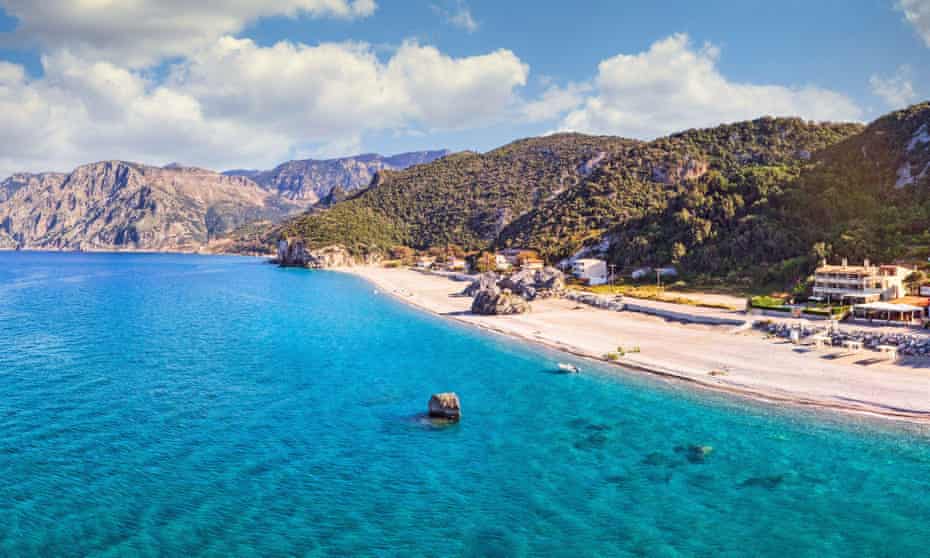
Photograph: Constantinos Iliopoulos/Alamy
Greece’s second-largest island, Evia is often overlooked in favour of more glamorous destinations. But this gem within striking distance of Athens is worth exploring for the variety it offers: some parts feel like Switzerland-on-sea; others resemble the Caribbean. It’s a two-hour drive from Athens, or a one-hour ferry crossing from the port of Rafina – yet very rarely busy.
What to do
In the north of the island the thermal springs of Edipsos are mentioned by Plutarch and Aristotle as the place Hercules went when he needed to restore his powers. More recent visitors have included Aristotle Onassis, Maria Callas, Winston Churchill and Omar Sharif. At the other end of the island, the Montofoli wine estate in Karystos offers tours and tastings of its four varietals including renowned dessert wines. Karystos hosts a wine festival at the end of August, and the estate has four pricey villas (€400 a night) for those who want to push the boat out. Hiking trails from Lamari or Stropones lead to the beach at Chiliadou on the east coast for a rewarding swim in clear waters framed by dramatic cliffs.
At Drakospita in the south, 23 megalithic structures with roofs made of huge slabs of limestone are known as dragon houses. They may have been sanctuaries to Zeus, Hera or Hercules, or ancient defensive structures. The mountain villages offer cool sanctuary in the height of summer, with lots of signposted hiking trails through the woods. Steni village is a personal favourite.
Where to stay
The Old Stone Cottage (€150 a night for four) on the outskirts of Karystos is a secluded spot with two bedrooms and beautiful views across the bay and a ruined castle. Villa Averoff (from €1,850 a week for eight) in the hill village of Kirinthos, is a tranquil 19th-century estate in extensive grounds with two grand mansions each accommodating eight (which can be rented separately or together with three smaller buildings sleeping 26 people all together).
Where to eat
Mouria grill (+30 2228 051234) in the leafy village square in Stení, in the middle of the island, serves hearty mountain food made with local produce such as kondosouvli (spit-roast pork), wild mushrooms and fried cheese bread. Gefsiplous, by the sea in Karystos, is a family-run restaurant serving simple salads, seafood and grilled meats.
Galaxidi
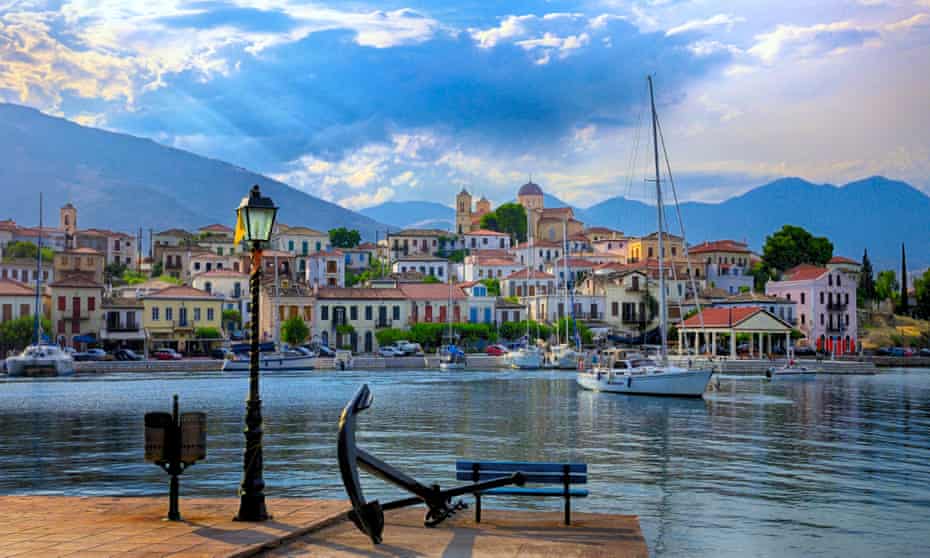
Steeped in maritime history, this pretty little town on the Gulf of Corinth below ancient Delphi is an overlooked gem. Just three hours west of Athens, the elegant neoclassical resort curves around the seafront and has the atmosphere of a Greek island. It was one of the country’s wealthiest ports in its 19th-century heyday and an air of grandeur remains. It’s authentically Greek and popular with sailing folk, without the tourist crowds.
What to do
The sleepy, unspoilt town centre is full of captains’ mansions with colourful facades, cobbled streets, traditional squares and seaside cafes (landmark church Agia Paraskevi and the Maritime Museum are worth checking out, too). The oracle of Delphi is half an hour’s drive away, with its temple complex and breathtaking views of the olive tree-covered valley below. On Clean Monday (Ash Monday, 7 March next year) visitors can join in Dyonisian Alevromoutzouroma (flour smudging), when locals in carnival costume throw coloured flour at one another to mark the start of Lent.
Where to stay
Ganimede (doubles from €65 B&B), a family hotel in Galaxidi’s port, Chirolakas, is big on traditional Greek hospitality. At breakfast, served in the flowery courtyard, everything is homemade – the jams, the curds, the chutneys. Owner Chrysoula’s husband is also a baker. Galaxa Mansion (doubles from €65 room-only, breakfast €10pp) in Galaxidi’s old port is a family-run hotel that also takes pride in traditional, homemade breakfasts. Local eggs, pies straight from the kitchen, and a famous take on strudel all feature.
Where to eat
Maritsa’s on the waterfront is one of the best seafood restaurants in town. Bebelis, a bit further inland, offers consistently outstanding taverna food in a traditional setting (lace curtains, fresh flowers).
Folegandros
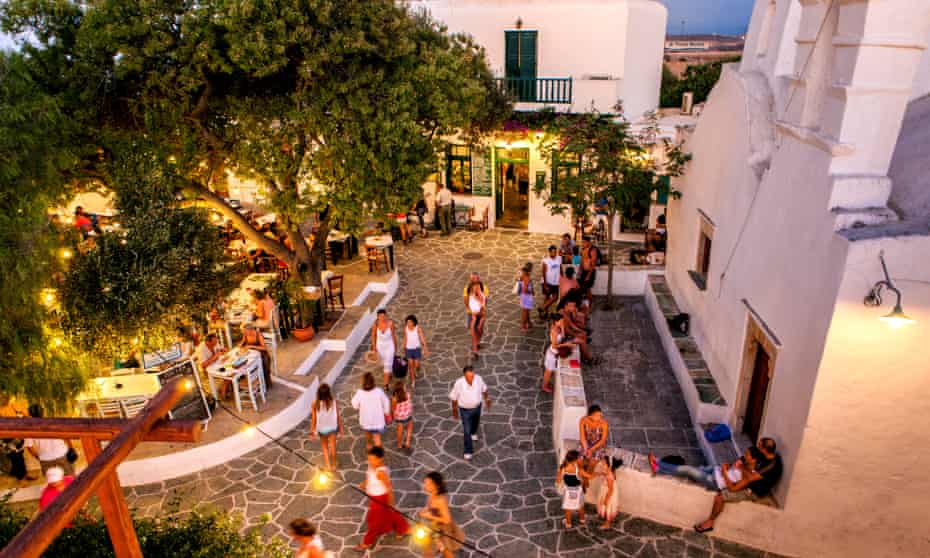
With just 765 inhabitants, and the feel of a less-discovered Santorini, Folegandros offers the chance to kick back and enjoy unhurried island life. The medieval Chora, the main town, is high on a rock, the scenery is dramatic, and the cobbled streets tranquil. The ferry from Piraeus takes about seven hours: good things really do come to those who wait.
What to do
Stroll around whitewashed Chora; follow the gently winding path to the top of the hill and watch the sunset from the Church of Panagia. There are boat trips to Chrysospilia cave on the north-east of the island (it’s one of the largest in Greece, with impressive stalagmites and stalactites) and scuba diving in clear seas. Beaches to check out include Vorina on the east coast (famed for its turquoise waters) and untamed Katergo on the island’s southern tip. Boats every hour from Karavostasis port or it’s a 20-minute hike from the road. Take water, as there are no facilities nearby.
Where to stay
Meltemi Hotel (doubles from €45) in Chora is unfussy and spotless, and the hosts make you feel so at home it’s hard to leave. Folegandros Apartments ( apartment for four from €126), also in Chora, make a comfortable base – and there’s a pool.
Where to eat
Miss Irini’s cafe in hilltop Ano Meria does Folegandrian specialities, such as handpicked capers in a red sauce, that will have you dreaming of your next meal before you’ve even finished. Piatsa restaurant, in a sleepy square in Chora, is great for people-watching and traditional Greek dishes.
Leros

One of the Dodecanese islands, in the southern Aegean near the Turkish coast, this tranquil oasis is an eight-hour ferry trip from Athens, though there are shorter routes from islands including Rhodes and Kos). Said to be the favourite island of goddess Artemis, it’s lush and hilly with many beautiful pebbly coves, and has a colourful history.
What to do
The Italian-influenced town of Lakki on the west coast was designed as a utopia by Mussolini’s architects during the occupation. Unusual buildings include a minimalist church and an art deco cinema. The larger town of Agia Marina in the east is known for its winding alleys, traditional houses and impressive mansions; nearby, 11th-century Panagia castle is a steep half-hour climb, and below it, Panteli is a fishing village with picturesque windmills. Secluded Dioliskaria beach, five miles north of capital Platanos, is one of the best, and for divers there are ship and plane wrecks to explore; book with Hydrovius Diving Centre (hydrovius.gr).
Where to stay
Bella Vista Apartments (from €70 a night for two) at Panteli beach are elegant, affordable and a stone’s throw from the water. Camping Leros (tent and two adults €18 a night) in Ksirokambos is set in an olive grove, and has an on-site diving club.
Where to eat
Taverna Zorbas in Panteli claims to be the oldest on the island and serves fish straight from the boat at tables overlooking the beach. A few paces along, El Greco is another place offering simple, delicious traditional fare.
Kythira
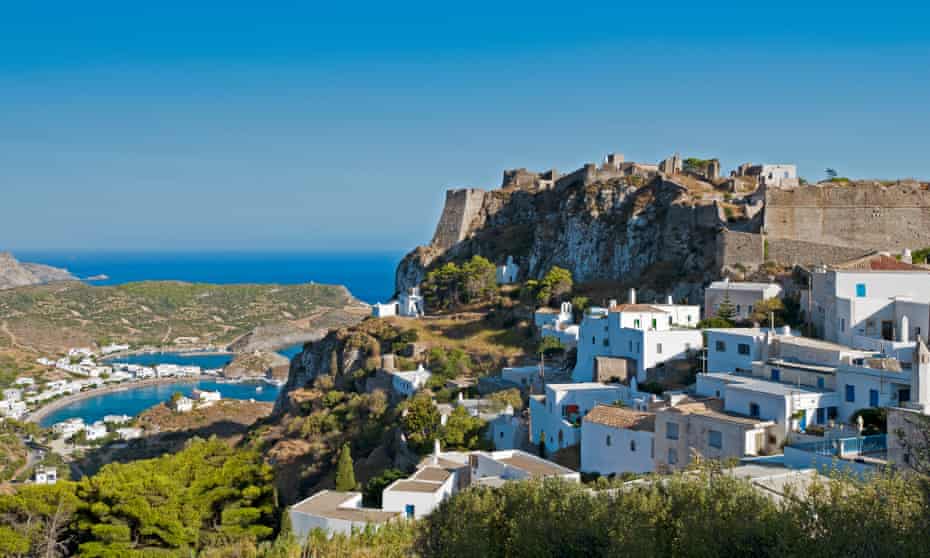
Birthplace of Aphrodite, this island off the southern Peloponnese lives up to the goddess’s name. Waterfalls, gorges, medieval fortress towns, beaches – it has them all. And because getting there feels like travelling to the end of the Earth – it also offers a sense of adventure. You can fly from Athens in 45 minutes, but getting there the slow way – a four-hour drive from Athens, and a short ferry ride from the town of Neapoli – builds the anticipation.
What to do
The most distinctive building on the island is the late 12th-century Venetian castle in Chora, the main town. Mylopotamos, in a wooded valley to the north, is named for the 23 watermills along its stream. From here a path leads up to the beautiful Neraida waterfall, in a designated area of outstanding natural beauty: its cool, crystalline pool is perfect for a dip. On Chytra island, reached by boat from Kapsali harbour in the south, there’s a seal colony and a cave with a stunning blue crystal pool.
Local walking guide Frank leads groups around Kythira’s abandoned villages and is a font of knowledge about flora and fauna, history, culture and daily island life. Kapsali or the family-friendly seaside town of Avlemonas on the east coast make a tranquil base for exploring the beaches and bays at Firri Ammos, Komponada, Kaladi, Sparagario, and Melidoni.
Where to stay
Chora View (doubles from €50 B&B, self-catering studios for four from €90) is a renovated 17th-century manor house beneath the Venetian castle and not far from Kapsali beach. The woman who runs it is contagiously upbeat, making this simple and traditional guesthouse a joy to stay at. Fos kai Choros guesthouse (doubles from €100 B&B, self-catering studios for two from €85) is owned by Albert and Anita, who moved from the Netherlands to start this boutique hotel between the picturesque villages of Aroniadika and Pitsinades.
Where to eat
Familia in the 14th-century village of Fratsia, specialises in Kytherian dishes such as aubergines with bulgur wheat, made with locally sourced ingredients. Skandeia in Paleopoli uses homegrown, organic vegetables, fish from nearby Avlemonas, and other island produce, and serves meals in a delightful former vineyard.
Astypalea
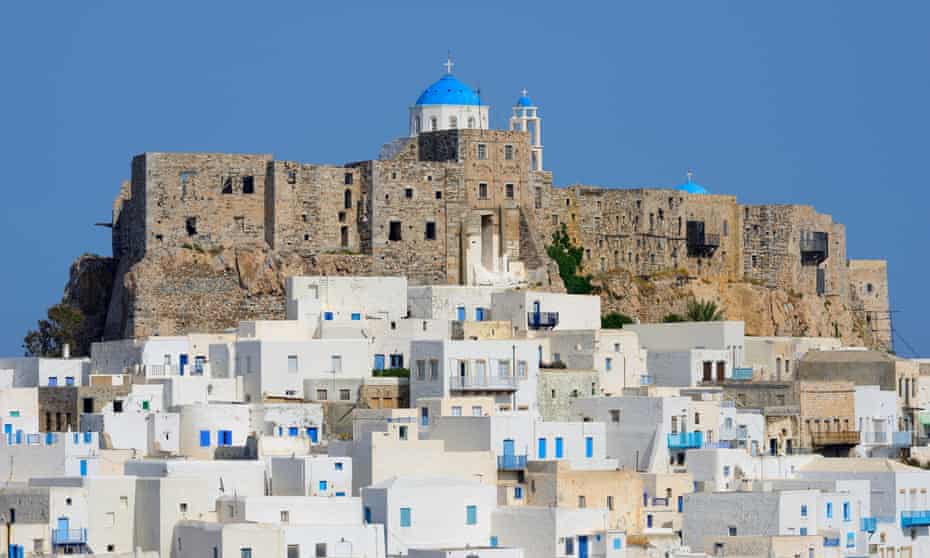
Astypalea is the kind of Greek idyll those who know the country well dream of escaping to. It’s safely off the beaten track thanks to its remoteness: ferries run three times a week from Piraeus and take nine hours. The whitewashed cubist villages have a hint of Santorini, the beaches are pristine and rugged – and the hospitality is generous and authentic.
What to do
In the main town – called, you guessed it, Chora – sparkling houses cascade down the hillside from Venetian fortifications. Though little remains of the castle itself, the views are worth the climb. The Archaeological Museum in Gyalos offers a history fix, and handily, just opposite, the best street food is available at Turquoise.
There are countless great beaches: Vatses, Kaminaki, Agios Konstantinos, Plakes, Maltezana, and Tzanaki, to name a few. The nearby islets of Kounoupes and Koutsomitis also make for a lovely day trip. Be sure to pick up some local saffron to take home. It grows wild on the island and is much more flavourful and aromatic than cultivated varieties.
Where to stay
Studios Kilindra (from €80 for two) in Chora offers four units under the castle with spectacular views. Akrotiri Studios (from €45 for two) in the resort of Maltezana offers traditionally charming, family-run studios, apartments and beachfront houses, with amazing views and well-equipped kitchenettes.
Where to eat
Astifagia restaurant, by the sea in Maltezana, serves beach-side Astypalean specialities with an innovative twist. And don’t miss Kafenio Meltemi in Chora, for traditional Astypalean sweets.
Syros
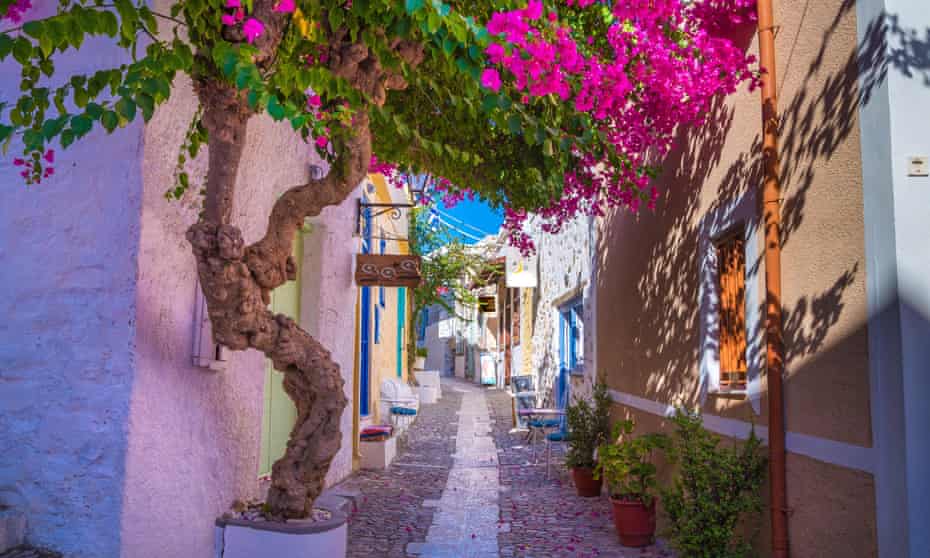
Eat, beach, sleep, repeat might sound appealing from the confines of lockdown, but if you want a little more from a Greek island, head to Syros. A year-round population, non-touristy shops and a vibrant cultural life make for a fascinating insight into the local lifestyle, with all the quaint villages and charming trimmings you would expect from a Greek island.
What to do
Lose yourself in the neoclassical main town, Ermoupoli. Swing by the impressive town hall, which was inspired by the palaces of Troy, and stick your head in the Apollon Theatre, a miniature of Milan’s La Scala. Ano Syros, a medieval settlement in the hills behind, is more labyrinthine in character, and Vaporia is the beach area of Ermoupoli, where imposing mansions perch above the sea.
The island’s beaches are quieter than many, too. Take a day trip on a boat from Kini beach, on the west coast, to Syros’s remote northern coast, where Grammata beach has ancient rock engravings. The real reason to go Syros, though, is the island’s rich cultural offerings, including concerts, performances, art exhibitions and events such as the Syros International film festival.
Where to stay
Wind Tales (doubles from €73 B&B), a boutique guesthouse in Ano Syros, oozes Cycladic charm and has terraces offering stunning views over the sea. Anemos kai Almyra (studios from €50) is a complex of clean, homely rooms with kitchens a few hundred metres from the west coast’s Delfini beach.
Where to eat
Cantina Analogue in Ermoupoli is an artist-run Aegean grocer and bistro. Expect Cycladic dishes with a twist, such as roasted celery root with tahini and raisins, and regular live music. Dyo Tzitzikia (two cicadas), near Kini beach, is best for seafood with sunset views.
Pilio
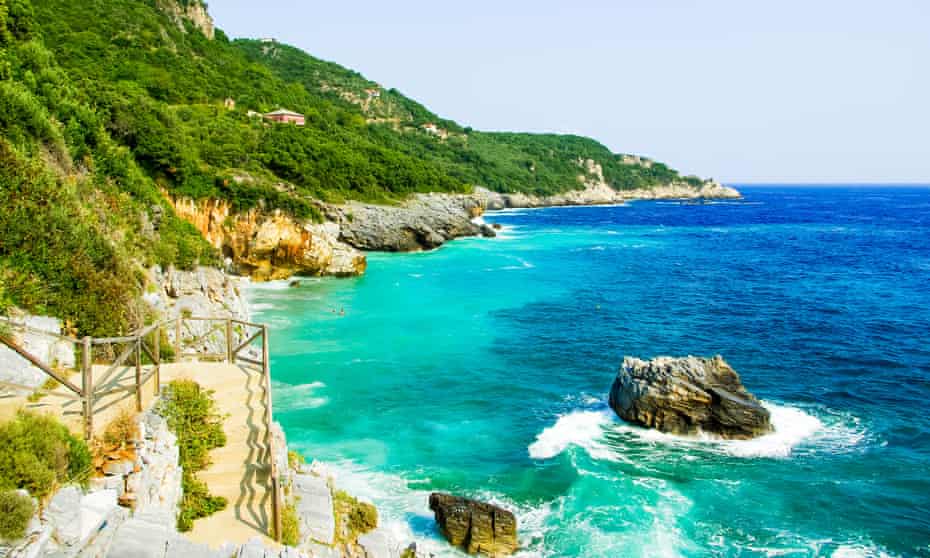
A mountainous mainland peninsula once known as the Greek gods’ summer retreat, Pilio (or Pelion)is a four-hour drive from Athens. Also known as the mountain of the centaurs, it’s a year-round destination offering mountain activities as well as coastal attractions, and was used as a location in the first Mamma Mia! film. Cliffs on its eastern side dip dramatically into the Aegean, to its west is the sheltered Pagasetic Gulf, and in between lie picturesque villages and green wooded valleys.
What to do
Villages and more villages. On the eastern slope of the mountains, Tsagarada boasts one of the oldest (1,000 years) and largest plane trees in Europe, the deepest gorge in Pelion (Koutra), and the beaches of Milopotamos, Fakistra and Karavostasia. Portaria and Makrinitsa villages offer views across the city of Volos.
From 18-31 August, nearby Agios Lavrentios runs a Music Village festival that attracts international musicians and artists. The Little Train of Pilio is another highlight. It started operating in 1895 and still climbs the peninsula’s beautiful slopes on its 90-minute ride. On the southern tip of the peninsula is the cave of the centaur Chiron, and the sleepy villages of Trikeri and Agia Kyriaki.
Where to stay
A stone’s throw from the square in Makrinitsa is Melanthi (doubles from €65 B&B), a 19th-century mansion with rooms overlooking the Pagasetic Gulf. Kritsa Gastronomy Hotel (doubles from €50 B&B) in Portaria is family-run, with its own organic farm and restaurant, offering cuisine including pies made with handmade filo pastry. Guests can take part in cooking lessons, pick the produce and learn about the history of the area through local dishes.
Where to eat
Aleka’s House in Tsagarada serves Greek dishes with a slightly modern twist, such as stuffed zucchini flowers and pork with cardamom. The traditional Salkimi taverna in the village of Milies (end of the line for the Little Train) specialises in filo pies with cured beef.
Mani, Peloponnese
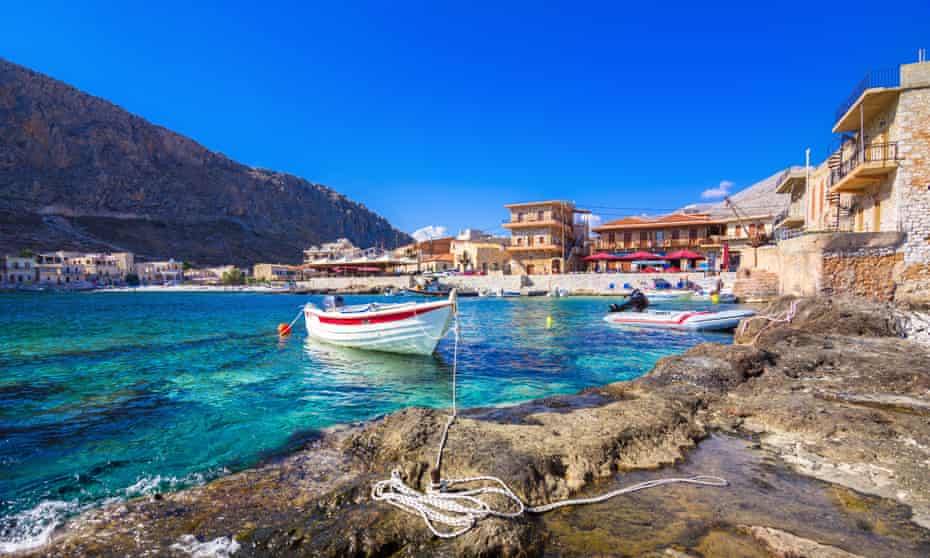
At the southern end of the Peloponnese, this is a wild, rugged region at times reminiscent of Tuscany. Medieval fortresses and tower villages dot the dramatic landscape, and olive groves run out to the horizon. Today the Mani offers peaceful sanctuary in a land once dominated by family feuds and vendettas.
What to do
The remains of the ancient city of Messini, at the top of the peninsula, are as extensive as those of Olympia and Epidaurus. South round the coast, Kardamyli – first mentioned in Homer’s epic poem the Iliad – was once the main port of the Greek city-state of Sparta, but is today an upmarket resort, with boutiques, cafes and bars. Kardamyli was also home to the travel writer Patrick Leigh Fermor, and his beautifully restored house is a holiday let. Rent a bike to ride dedicated trails from Stoupa to Agios Nikolaos and the impressive Diros caves; in the other direction are the Polylimnio waterfalls on the way to Pylos, and Navarino Bay for a cooling dip. The area’s best beaches are at Stoupa, Gerolimenas, Limeni and Kalogria.
Where to stay
Zen Rocks ( doubles €186 room-only, cheaper dorm rooms also available), about 15 minutes from Kardamyli, is a peaceful retreat centre in an olive grove in the foothills of the Taygetos mountains and with views over the Messinian Gulf. Breakfast, dinner, yoga, zen meditation, massage and ayurvedic consultations are also on offer. Elies Hotel and restaurant (self-catering studio from €104 a night) by a pebble beach on the outskirts of Kardamyli has 24 secluded stone cottages also in an olive grove.
Where to eat
Lela’s in Kardamyli is a family-run taverna right on the waterfront where local ingredients, including their own olive oil, shine through in dishes such as siglino, a traditional Maniot cured meat. Lofos tis Santovas near Megali Mantineia, with views of the Messinian gulf, is a favourite with Greeks from Kalamata city, a 20-minute drive away. Ingredients from the family farm are made into dishes such as roasted rooster with potatoes.





